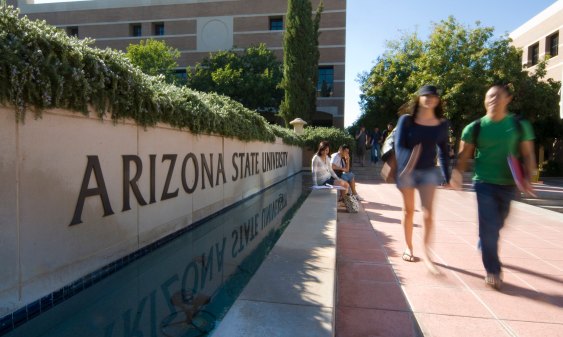EDUCAUSE’s Malcolm Brown on transforming higher ed with technology

Malcolm Brown enjoys what some might see as a front-row seat on how technology is changing the landscape for learning in higher education.
His familiarity with the evolution of academic computing dates back to the 1980s when he went to work for Stanford University and later served for nearly two decades as Dartmouth College’s director of academic computing.
But his view of technology’s relentless impact on higher education has widened since taking on his current role in 2009 as director of EDUCAUSE’s Learning Initiative, where he leads the association’s support efforts to advance teaching and learning through innovative uses of technology.
The job brings together what Brown calls “an interesting, somewhat eclectic mix of players in this space. No one campus office organization has exclusive responsibility for teaching and learning.”
“The community that we cultivate has IT people in it, for sure, because EDUCAUSE is an IT organization, but we also cultivate a community of instructional designers, provosts, deans, people who work in libraries, people who work in teaching, learning centers … who are deeply committed to the support of the teaching and learning mission.”
Much of his current focus revolves around a new community of practice called Leading Academic Transformation, he told EdScoop in a recent interview. His efforts, along with the results of a new survey on key issues impacting higher education will culminate in Houston in February at ELI, one of EDUCAUSE’s annual meetings.
“What we’re trying to do is to bring together the senior leadership of the campuses who are responsible for teaching and learning support and create a community of practice, so they have the capacity or the mechanism to share best practices, to find common solutions, co-invent and collaborate on approaches to the challenges that are facing higher institutions with teaching and learning today,” he said.
Transformational change
The drumbeat for academic transformation grew loud and clear from last year’s ELI annual survey, Brown said.
“I think everyone is sensing that we need something powerful – more strategic types of transformations in our teaching and learning mission, in addition to all the day-to-day fixes and improvements and work that we do,” he said.
Brown acknowledged that many colleges and university remain in historically established silos in their uses of technology and that not everyone sees technology from the same perspective.
“A lot of [faculty] are still very skeptical about whether online learning can be as good as face to face learning,” he noted.
But Brown also believes higher education officials have reached a tipping point where they must not only embrace new ways to use technology, but must also tackle the challenges inherent in managing institutional change.
“That’s exactly why we formed that community of practice, because you have everyone saying, ‘We support teaching and learning,’ but how are you going to bring that together and coordinate it? Do I go to the IT shop? Where do I go for this for help?’” he said.
“If you’re going to think about doing something transformational, then you’re going to have to really approach and be deliberate about change management. You can have the best idea in the world about how to improve teaching and learning at your campus. [But] if you can’t help the culture change, to accept it, get the innovation to diffuse in that way, obviously it’s going to be a pretty frustrating experience,” he said.
Legos Model
Asked how the technology industry could help, Brown had a simple answer: “Adopt open standards.” He then told a story:
“Eighteen months ago, we did some research based on some funding we got from the Gates Foundation. Their question was: ‘What should the next learning management system look like?’ We didn’t get very far in that research before we realized that that was entirely the wrong question.
“The question is not what the next LMS should look like. The question is what should our next generation digital learning environment be able to do? That’s an important distinction, because you’re no longer thinking about, ‘Oh, I just have to get a better piece of technology in place, and then my environment’s going to be what I need it to be.’ Instead, we need to think about what we want it to be, what kind of activity and things that we want the environment to support, and then what do we need as a technology basis to make that happen?
“Our conclusion was there’s not an element. You might still have an element, but what we thought is that because of the huge diversity in teaching and learning in higher education – regular undergraduates, adult learners, first-to-college, people with various needs, various learning abilities, various disciplines – how can one single application serve all those people? It can’t.
“It became clear very quickly in our research that you needed to adopt a Legos approach to your learning environment. Legos work because you can have a piece of any design – as long as it adheres to certain standards – that allows it to be connected to another Lego piece. You can have pieces of all sorts of designs and build anything you want, because the pieces at some level have this standard about how big that little round knob is so they can intersect and connect. We adopted that approach.
“We said, so the next learning environment is going to be one that is a component-based architecture. Instead of a big, hulking single application, it’s going to be a component-based architecture. That means that various technology components, like the applications and the LMS, whatever it might be, have to be connected via open standards. Open standards are the critical step forward in getting towards a next-generation digital learning environment,” he said.
Next Steps
Brown argued that the higher education world is “making some progress” toward common standards. He pointed to the Learning Technology Interface (LTI) standard from IMS Global.
LTI “allows you to hook up an application to an LMS, or one application to another, without having to custom-design by hand an interface and design and write code to make these things hook up. They just lock in place, if they both adhere to the standard,” he said.
Brown said while the standard isn’t perfect, “there’s good acceptance” and that the education community will soon be moving to version two of the standard.
There are other new standards coming on stream around badging and learning analytics data, including Caliper, he said.
“There’s a lot still to go,” he said. “It’s promising, because when it is in place, it’s kind of like magic. It’s a bit like your smartphone. You just download the app. You don’t have to do anything special. It just runs.”




